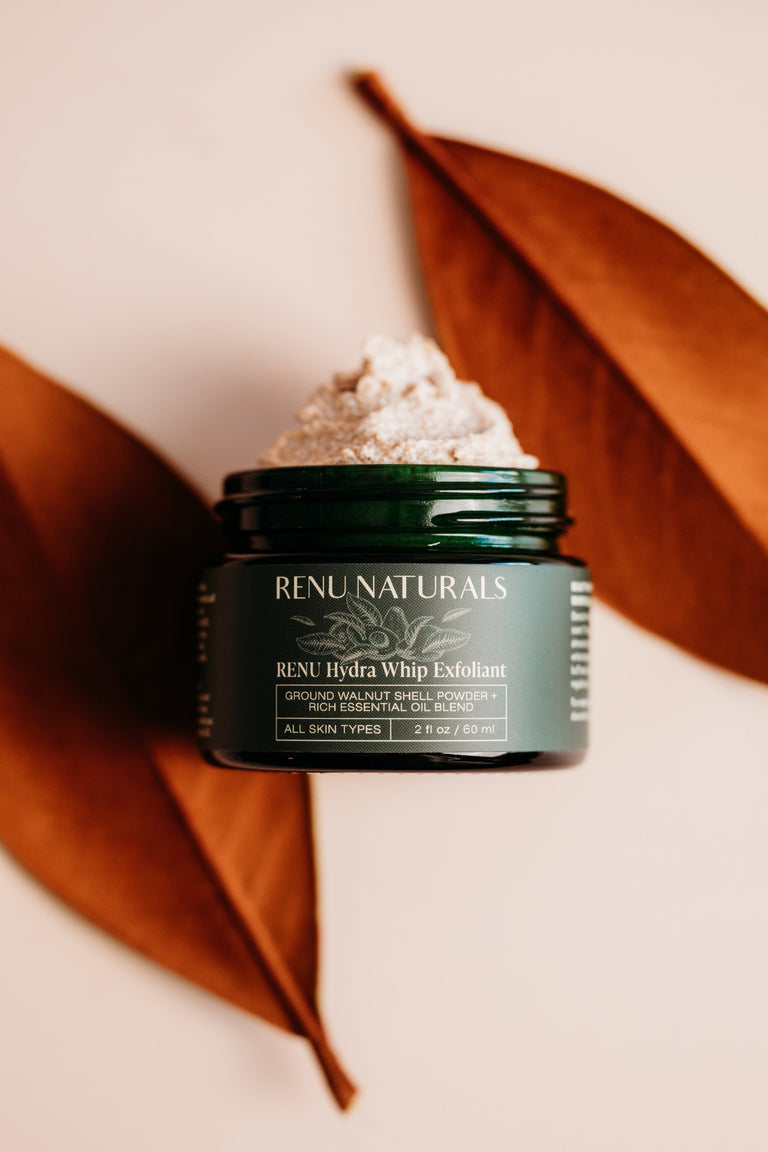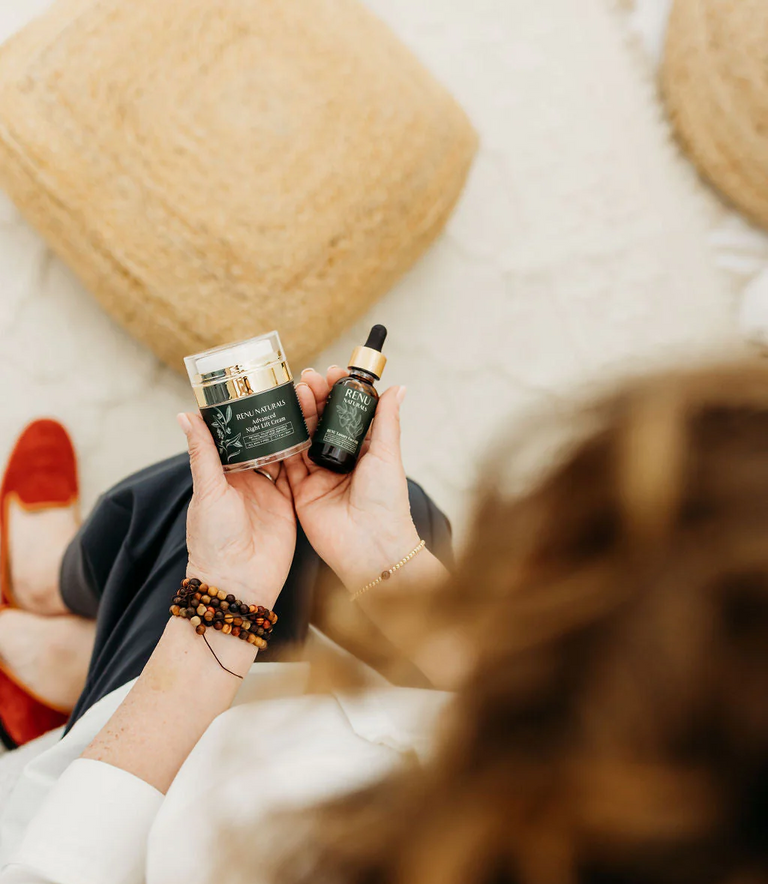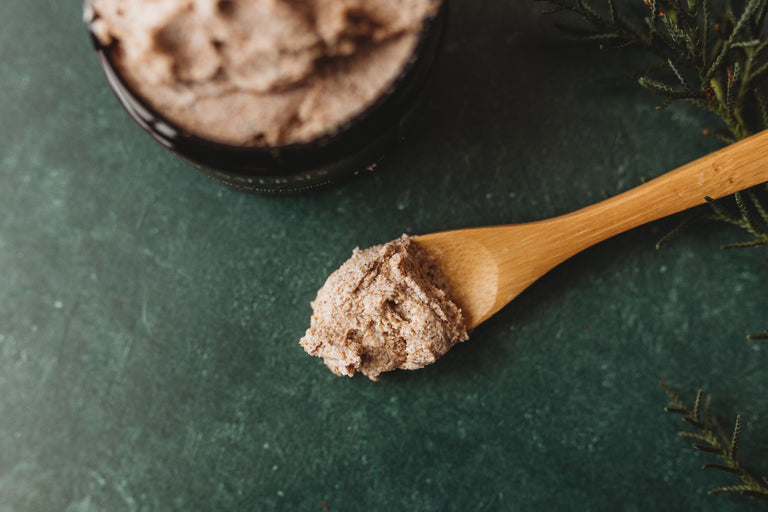
Crepey Skin? Here's what you CAN do!
TAGS
RECENT ARTICLES

Your Fall Skincare Refresh: A Guide to Hydrating Your Skin
As the seasons change and the air turns cooler and drier, it's time to adapt your skincare routine. The lightweight products that worked for you in summer may not be enough to combat the dryness of fall. Now is the perfect time to adjust your regimen with richer, more hydrating options.
Step Up Your Hydration with a double Cleansing Routine and Moisturizer
Your skin's needs change with the weather. While a light cleanser and moisturizer may have been perfect for summer's humidity, you'll likely want to switch to more nourishing formulas for fall. Using our RE+NU Cleansing Oil + Gel Cleanser as a double cleanse removes makeup and impurities without stripping your skin. This process leaves your skin feeling clean, soft, and ready for your fall routine.
Consider a richer Moisturizer with key ingredients like ceramides, which are essential fatty acids that help replenish the skin's natural barrier in colder temperatures. For a natural alternative, our Nourishing Night Cream is formulated with citrus oils to moisturize without clogging pores. Our Repair Eye Cream is also a must-have, as this delicate area needs a concentrated formula to address signs of aging and stress.
While cleansing and moisturizing are crucial, they aren’t the only steps to a healthy fall routine.
Key Steps and Products to Add This Season
You don't need to completely overhaul your routine. Instead, focus on adding a few key steps to boost hydration.
Oxygen Mask for a Revitalizing Boost
A face mask can deliver a powerful surge of moisture and nutrients, and our Oxygen Mask with CoQ10 and Fruit Extracts provides a revitalizing boost. Adding this mask to your routine a few times a week will help prevent dryness and give your skin a smoother, softer, and more radiant look.
This unique formula works to unclog and decongest pores, allowing your other products to be absorbed more effectively. With a blend of fruit extracts and CoQ10, your skin will be left looking healthy and feeling refreshed.
Don't Skip Exfoliation (Just Do It Less) Exfoliation is still important for removing dead skin buildup, but your skin is more vulnerable to irritation in cooler weather. Cut back on exfoliating to once every two weeks with our gentle Hydra Whip Exfoliant. Follow with a serum and a moisturizer to protect your skin.
Switch to a Hydrating Toner While clarifying toners are great for summer, a hydrating toner is perfect for fall. Look for an alcohol-free formula that helps strengthen your skin's barrier and delivers hydration. Our Organic Rose Petal and Hibiscus Toner is rich in minerals, vitamins, and antioxidants to hydrate and balance the skin, and to help minimize the appearance of pores.
Add a Serum to Your Routine Serums have smaller molecules and a higher concentration of active ingredients than moisturizers, allowing them to penetrate deeper into the skin for faster results. Adding a serum can address specific concerns like wrinkles, dark spots, and dehydration. Using a serum in conjunction with your moisturizer will lock in hydration and give you a smoother, healthier complexion. Consider our Vitamin C Serum with Matrixyl to brighten your skin and protect it from environmental stressors.
Will You Be Making These Changes?
Just as you adapt your wardrobe for the new season, your skincare routine needs to change, too. Protecting and hydrating your skin is key as the temperature drops. By swapping your cleansing routine, upgrading your moisturizer, and adding in a serum, mask, and eye cream, your skin will look brighter and more radiant all season long.

How Skincare Ingredients Penetrate Your Skin (and Why It Matters)
Does Your Skincare Actually Sink In? The Truth About Product Penetration
Ever wondered if the skincare products you are investing in are actually being absorbed by your skin? Never mind the associated costs and the desired results, let's delve into the reality of ingredient penetration and absorption to deliver on those stated claims.
Let’s take a look at the function of the skin, our largest organ, and how it operates as our protective barrier.
The skin is made up of three layers:
- The epidermis, known as the waterproof barrier, sits at the top. Within the epidermis is the stratum corneum, which is made up of dead skin cells arranged like tiles on a roof, overlapping one another and glued together with fatty acids.
- The dermis is the middle layer of the skin and where elastin, collagen, connective tissue, blood vessels, hair follicles, and sweat glands reside.
- And finally, the bottom layer of the skin is called the hypodermis, the innermost layer of the skin that comprises fat and connective tissue.
When talking about skincare products, it's important to note that skin is not a sponge. "Most topical skincare products work on the surface of the skin, in the epidermis (top layer), and only a small percentage of ingredients are absorbed deeper to reach the dermis," confirms board-certified dermatologist Dr. Shereene Idriss.
This is because the stratum corneum, with its tight network of cells and lipids, is designed to keep things out, acting as a formidable barrier against the outside world.
Factors Affecting Absorption:
While the skin's barrier function is a primary factor, other elements influence how well skincare products penetrate:
- Molecule Size: Smaller molecules have a better chance of passing through the stratum corneum.
- Lipophilicity: Ingredients that are "oil-loving" (lipophilic) can more easily integrate with the skin's lipid-rich environment.
- Concentration: A higher concentration of an active ingredient may lead to increased penetration.
- Formulation: The way a product is formulated (e.g., serum, cream, ointment) affects its ability to deliver ingredients.
- Skin Condition: Compromised skin barriers (due to dryness, irritation, or conditions like eczema) may allow for greater penetration.
- Application Technique: Gentle massage can sometimes enhance absorption by increasing blood flow and contact time.
Ingredients That Actually Penetrate:
While most ingredients stay on the surface, some have been shown to penetrate the stratum corneum to some extent. These include:
- Small Molecular Weight Ingredients: Hyaluronic acid (in its smaller forms like hyaluronate), certain peptides, and some vitamins (like Vitamin C) can penetrate to a degree.
- Vitamins: Other vitamins like Vitamin A derivatives (beyond just retinol, such as retinyl esters) and Vitamin E can also penetrate to some extent. Niacinamide (Vitamin B3), although primarily known for its barrier-strengthening properties, can also penetrate the stratum corneum.
- Lipophilic Ingredients: Retinoids (like retinol) are oil-soluble and can effectively penetrate the skin.
- Chemical Exfoliants: AHAs (like glycolic and lactic acid) and BHAs (like salicylic acid) work by loosening the bonds between skin cells, allowing for better penetration of other ingredients.
- Enzymes: Certain enzymes, like papain or bromelain (derived from papaya and pineapple, respectively), can have exfoliating effects and potentially enhance the penetration of other ingredients by breaking down proteins in the upper layers of the skin.
-
Squalane: (From Olive Oil): A highly emollient lipid that is easily absorbed into the skin.
Glycolic Acid: Another AHA and a potent chemical exfoliant that penetrates the stratum corneum. - Calophyllum Inophyllum Seed Oil: (Tamanu): An oil known for its ability to penetrate the skin.
-
Essential Oils: Some essential oils contain compounds that may enhance penetration, like Lavender, Lemongrass and Citrus Oils.
- Carrier Systems: Some formulations use "carrier systems" like liposomes or microencapsulation to help deliver ingredients deeper into the skin.
Tips for Maximizing Product Absorption:
While you can't drastically alter your skin's natural barrier, you can optimize your skincare routine to improve product absorption:
- Cleanse Properly: Start with a clean base using Lactic Acid, An AHA that exfoliates and can enhance the penetration of other ingredients.to remove dirt, oil, and debris that can hinder absorption.
- Exfoliate Regularly: Gentle exfoliation (physical or chemical) removes dead skin cells, allowing products to penetrate more effectively.
- Apply Products in the Right Order: Apply thinnest to thickest. Serums with smaller molecules should generally go on before heavier creams.
- Use Targeted Treatments: Serums and concentrates often have higher concentrations of active ingredients designed for better penetration.
- Consider Occlusives: Applying a layer of an occlusive like the RE+NU Luxury Beauty Oil as the last step can help to seal in other products and enhance their absorption.
- Be Patient and Consistent: Results take time. Consistent use of well-formulated products is key.
The Takeaway:
While your skin is a powerful barrier, certain ingredients and formulation techniques can help skincare products penetrate beyond the surface. Understanding the factors that affect absorption can help you make informed choices about your skincare routine and maximize the benefits of your products.
What are your favorite tips for maximizing skincare absorption? Share them in the comments below!

The Power of Exfoliation: Unlocking Radiant Skin ✨

What is Face Exfoliation?
5 Reasons Why You Should Exfoliate Your Face
1.) Removes Dead Skin Cells & Promotes Cell Turnover
2.) Improves Circulation
3.) Unclogs Your Pores
4.) Allows For Better Product Absorption
5.) Brightens Your Complexion

5 FAQ's About Face Exfoliation
Q: Is it OK to Exfoliate Your Face Daily?
Q: Is it Better to Exfoliate at Night or in The Morning?
Q: Should I Moisturize After Exfoliating?
Q: What Happens if You Don't Exfoliate Your Face?
Q: Do You Use Face Wash or Scrub First?
How to Exfoliate Your Face in 3 Easy Steps
Now that we've gone into what face exfoliation is, the benefits, and answered some frequently asked questions, let's go into HOW to exfoliate your face for the best results.
Step 1: Scoop out the product into the palm of damp hands and blend it into a mousse like consistency.
Step 2: Apply to your wet face. You'll want to start at your cheeks and move into a circular motion, moving up towards your nose and forehead.
Step 3: Rinse your face with warm water (not hot), and gently wash away the product. You can repeat this 2-3 times a week after cleansing your face with a cleanser.
